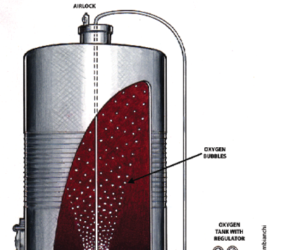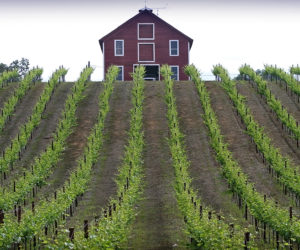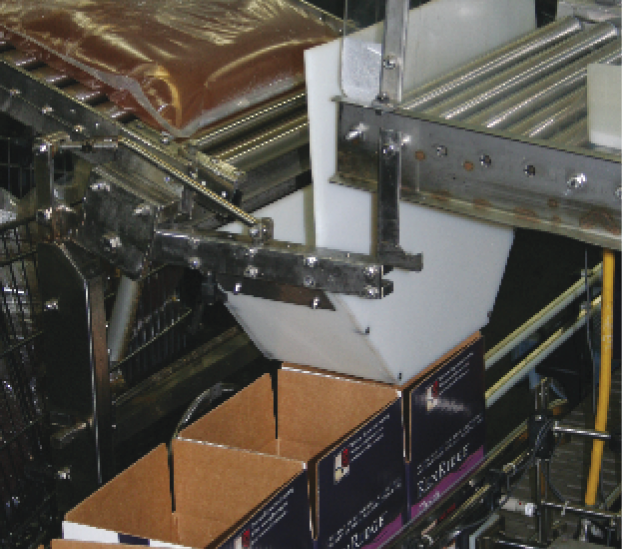
Unless you work in the industry, you’ll likely never have seen the inside of a wine kit manufacturer’s facility. For liability reasons, they don’t give tours to civilians. There’s something about running folks over with a forklift or dousing them in high-strength sanitizers or par-boiling them with live steam that makes lawyers twitchy. And as shiny as the kits are, there’s nothing to show how grapes go from the vine to your fermenter.
There is some merit in reviewing the history of kit making. Up until the 1970s, home winemaking meant grapes. When the first wine kits began to appear, they featured cans of Pasteurized grape concentrate and packages of acid, nutrient, tannin and oak, along with the yeast. While complete, and capable of fermenting into a wine-like beverage, they were very hands-on and . . . well, they really weren’t that great. Whether you made red or white, you actually wound up pretty much with a shade of beige, due to the very long boil the cans of concentrate went through to Pasteurize them.
Still, people persisted and as the wine industry grew, innovation followed. In the mid-1980s, two businessmen (Doug and Ross Tocher, who founded Brew King, one of the first wine kit companies) tackled the modern kit: they mixed concentrates with fresh grape juice, adjusted and balanced the blend exactly like a winery would, and aseptically packaged into bag-in-box ‘kits’. The techniques they used still form the basis of kit manufacture today.
How Wine Kits are Made: Sourcing
For the most part, kits are made exactly like wine ⎯ at least in the beginning. Step one is sourcing grapes. The major kit manufacturers don’t actually own the vineyards that produce the grapes they use. Well, actually that area is a little grey: since the two largest manufacturers in the world are owned by a gigantic international winery conglomerate and Canada’s largest winery respectively, there is a wee bit of overlap on grapes here and there. But the bottom line is that unlike a Chateau-type winemaking operation they get nearly all of their grapes from contracted vineyards, or the open juice market.
To start they contract to purchase grapes from growers by specifying conditions at harvest (acid, pH, Brix, and color) and organoleptic qualities (flavor and aroma). These specifications are very rigid, for although the grapes may change radically from harvest to harvest, the kits must maintain very high levels of consistency, so consumers can make repeat purchasing decisions. When the grapes are ripe they are harvested and taken to a winery facility to be processed.
These facilities can be contract processors who handle grapes for wineries that lack the equipment. They may also be co-operative wineries that do winemaking for many different vineyards (very common) or they may be actual wineries that do outside processing to maximize the return they get on their equipment investments.
Grape processing takes place right in the growing region the vineyard is located in—there’s not much point in shipping whole grapes to the wine kit companies, most of which are in Canada. While it would be possible to ship whole grapes from within the continental US with an expectation they’d arrive in reasonable condition, it wouldn’t work for grapes from Europe, Australia, South Africa, New Zealand, etc. Also, it would be a tremendous waste of shipping resources: grapes have an awful lot of cellulose, lignins, seeds and other gunk, such as MOG—Material Other Than Grapes—which might contain leaves, mouse-nests, dirt, lizards, etc. that take up space and weigh a lot. What wine kit companies are interested in is the juice from the grapes.
How the Grapes are Processed: Juice
If you’ve ever seen or participated in traditional grape winemaking, then the steps taken to turn grapes into juice won’t be a mystery: grapes arrive at the winery and are assessed and sorted. White and red grapes go to a crusher-destemmer and almost always receive a light dose of sulphite right at crush, to keep indigenous yeast and other potential spoilage organisms suppressed while they’re being handled, and to reduce any chance of oxidation.
Grapes for wine kits also get a cocktail of enzymes, including pectinases and some extremely specialized pectinoglycolytic enzymes. Pectinases work on pectins, the stuff that makes fruit into jelly. In wine it can cause cloudiness, and reduces pressing yield, as sticky, slightly thickened juice is harder to separate from seeds and skins. The pectinoglycolytic enzymes are very interesting: they work to break down the cellulose that comprises much of the structure of the grape’s skin. This causes the skin to release both aromatic and color materials into the juice as it breaks down.
Breaking the skin down isn’t a great concern with white grapes, as they are pressed very shortly after being crushed, sometimes going from the crusher pump right into the press. Highly aromatic grapes might be held on the skin for a few hours or overnight to pick up some of the scent from the grapeskins, but never for longer than this as the white juice would begin to pick up unpleasant levels of tannin if it was in contact any longer.
As the white juice runs off, it is very coarsely strained and pumped into jacketed, temperature-controlled settling tanks. The juice is pumped in at right angles to the side of the tank, starting a ‘whirlpool’ motion, and as it flows it is injected with a steady stream of rehydrated bentonite.
Bentonite is a clearing agent, often used after fermentation to remove charged particles, colloids, proteins and other goo. In this case it helps clear the wine to a very great degree, turning a turbid and murky juice sparkling clear. The whirlpool action ensures that the bentonite, which is heavier than the wine, stays in suspension long enough for it to attach to the particles in the wine and pull them down as it settles out. Once the tank is full, the pumps are shut off and the cooling coils go to work, chilling it down very rapidly, until it’s very close to freezing. This crash-chilling aids in clarification and helps to suppress any spoilage organisms that might have recovered from the dose of sulfites at the crusher.
After several days the now-clear white juice is pumped out of tanks, sometimes getting a very light filtering, depending on how it will be processed next: single-strength grape-juice is often unfiltered, retaining a bit more solid material as it’s taken to a Pasteurizer or freezing facility, while juice intended for concentrate needs to be very clear.
Red grapes are a bit different. If you peel a red wine grape you’ll notice that in most of them the flesh isn’t red in the slightest. Instead, it’s a pale yellow color. All of the color of the grape is located in the skin, along with a lot of the aroma and flavor, and half of the tannin (the rest of the tannins are in the grape seeds).
In traditional wine fermentations these components are extracted when the crushed grapes (called ‘must’ at this point) are attacked by yeast. As the yeast converts the sugar in the pulp into carbon dioxide and alcohol, the alcohol solubilizes and extracts the rich red color, aroma and tannins.
This isn’t possible for kit juices, as the kits can’t legally contain any measurable percentage of alcohol. Instead, red grapes for kits are subjected to enzyme maceration and a mechanical maceration as well. The crushed, de-stemmed must is pumped into an unusually shaped tank known as a roto-fermenter. A bit like a front-loading washing machine and the size of a couple of semi-tractors, the drum on the fermenter is ribbed on the inside and rotates slowly, tumbling the must, gently smashing and macerating the skins, without crushing the seeds. This comes close to the very old-school technique of foot-stomping grapes, which similarly mechanically agitates the must gently and slowly.
As the roto-fermenter turns, those pectinoglycolitic enzymes mentioned earlier do their work, breaking down the grape skins, releasing all of the desirable colors, flavors and aromas into the must. It also goes to work on the seeds, breaking down the outer coating, pulling out the other half of the tannins, rounding out the tannin profile in exactly the same way an alcohol extraction does.
After 48-72 hours the maximum extraction levels are achieved and the must is pumped off, pressed and settled with bentonite in exactly the same way the white juice was processed, and like the white juice, some is stabilized for shipping, and some goes to a concentrator facility.
From Juice to Concentrate
Some concentrating facilities are purpose-built by the same people who process juice. They make concentrate for their own operations and for re-sale to other wineries. Others are owned by major wineries and while they do re-sell concentrate, for the most part they produce it for their own operations.
One of the largest of these juice and concentrate processors is located in California. If it were legally advisable to tell you the company’s name, it would be instantly recognizable. From the air, the facility looks like a sprawling, gleaming oil refinery, with tank farms and refining towers as far as they eye can see. It exists because of a unique challenge they have with the scale of their operation: they harvest a truly astounding amount of grape material over the season. During the six weeks they bring grapes in, there is a line of trucks miles long waiting to take the exit from the highway into the facility. As soon as a truck enters the marshalling area it drops its trailer and races off without even a look back, running out to bring another load in around the clock. It’s so much grape material that they actually begin harvesting when the grapes are slightly under-ripe, and finish when they’re verging on the over-ripe, but with that much tonnage, there’s no other way to do it.
Turning all of those grapes into wine at the same time would require an enormous amount of fermenting tank space, and would occupy a lot of winemaking man-hours . . . but only for a few months each year. Once the wine was fully processed and bottled the tanks would sit empty for the rest of the year, and the winemakers idle. This is anathema to an accountant’s heart.
Clever fellows, they use an approach that requires fewer tanks and winemakers, fermenting smaller batches continuously, all year long. The way they do this is by storing a lot of their grape material in the form of concentrate, which takes up one-third to one-fifth the volume of fresh juice, and can be stored for extended periods of time without deteriorating. Then, when they have free fermenting space they rehydrate the concentrate, mix it with fresh juice and ferment it into commercial wine. Once it’s in the bottle, they start another batch and keep inventory turning over on a continuous basis.
It’s such an excellent system that the wine kit companies are glad to borrow it, and repurpose it into a consumer-friendly format. (It’s true: we didn’t invent wine kit technology, we just borrowed it from the big guys).
While there are some interesting technological schemes for making concentrate by various processes, 95%+ of all concentrates are made in vacuum distillation units. These vacuum concentrators work like the reverse of a pressure cooker. Inside a sealed vessel the expansion of water vapor increases the pressure, raising the boiling point of water until things inside cook very rapidly.
By reversing this and lowering the pressure inside a sealed tank, water can be made to boil at very low temperatures—low enough that if you could reach inside you could stir the rapidly boiling must with a bare hand! Boiling the juice at low temperature keeps it from ‘cooking’, preventing browning and caramelization, preserving the fresh taste of the grapes. The water comes off as low-temperature vapor, eventually leaving behind concentrated grape juice.
An interesting addition to the process is essence recovery. Some aromatic compounds can be carried away in the water vapor, and a fractional distillation apparatus is attached the concentrator recover these essences, which are returned to the concentrate after processing.
How Concentrated is Concentrated?
In the old days all juice was pushed through a multi-stage rectifier, meaning it travelled through a series of concentrator elements, and at each stage more and more water was removed, until it hit 70° or 80° Brix. Brix is the measure of sugar content of an aqueous solution, more precisely, the percentage mass of sugar in that solution. While grape juice isn’t a plain solution of water and sugar (it’s got tannins acids and other solids too), Brix is a useful tool for comparing juice and concentrate. Grape juice could arrive at the concentrator at 20-25° Brix, but it usually left much higher.
Nowadays, however, it could leave only slightly higher. It was discovered that even with essence recovery, some of the character of fresh juice was lost to the concentration process. By reducing the number of rectifier elements in the concentrator the juice comes out lower in Brix, but higher in aroma and retained solid material. This gives much more intense varietal character and aroma. The trade-off is that kits that using this lower-density concentrate will necessarily be of higher volume, and the more rectifier elements left out, the tastier the finished wine, but the larger the volume needed to package the kit, one of the reasons for the ever-increasing size of premium wine kits (the other being the continued increases in the use of unconcentrated juice).
Arrival and Storage
The juices and concentrates are then shipped from their country of origin and processing to the wine kit manufacturer’s facility. After Quality Assurance testing, concentrates are pumped into nitrogen purged sterile tanks until needed and juices are either blast-frozen rock solid (at -18°F) and held in a freezer facility, or stored in the kit company’s refrigerated cellars.
In the cellars, fresh juice is pumped into the same sort of nitrogen purged sterile tanks used for concentrate and held at very low temperatures, usually for about three months before being used in kits. This cold-storage time helps in the formation of wine diamonds (crystals of potassium bitartrate from the tartaric acid naturally occurring in the wine). Although not all of the crystals can be extracted from unfermented juice, it is usually sufficient to keep bottles from getting unsightly levels of tartrates, post-fermentation.
The cold temperature also helps preserve the juices until they are to be used, but there is another crucial step in keeping the juices fresh: as soon as they enter the cellar they are blended with concentrate. This has to do with pH and sugar levels, and how they affect preserved foods.
If you consider jam, it is a solution of fruit, acid and sugar. The reason jam doesn’t immediately spoil in the jar is because it has been Pasteurized—a process wine kits are subjected to—but Pasteurization alone would not be sufficient to keep the fruit concoction from going off. The other elements are the sugar and acid. Extremely high sugar levels are actually toxic to micro-organisms due to something called osmotic pressure.
Without getting terrifically science-y, osmotic pressure is the hydrostatic pressure produced by a solution in a space divided by a semipermeable membrane due to a differential in the concentrations of solute. Think of it this way: when you brine meat (or for vegetarians, perhaps when you salt raw eggplant) the liquid inside the cells of the product you’re subjecting to high levels of salt wants to cross the semi-permeable membranes of the cells in order to dilute the salty brine (yes, biology majors, that’s simplistic, but I did say we weren’t getting science-y). That salted eggplant releases a lot of liquid as the cells of its flesh expel liquid across their permeable membranes, trying to balance the differential in the solution.
When you vastly increase the sugar levels of jam (or grape juice by concentrating it) you increase the osmotic pressure on any spoilage organisms to such a degree that all of the water gets sucked out of their cells, dehydrating and killing them.
To explain how the extremely high acid levels preserve the concentrate, we can return to considering jam: high levels of acid lower the pH of the solution—it’s not necessarily a linear relationship because different things affect it by buffering the acids, but in extremely general terms, more acid equals lower pH, which means less bacterial/yeast activity—lower pH is why yogurt lasts longer than fresh milk.
Concentrate is, therefore, an excellent preservative for fresh grape juice because the very high acid levels it contains lowers the pH, and it increases the sugar content, which brings us to the crux of why all wine kits contain concentrate: without the addition of concentrate it is impossible to preserve fresh juice at room-temperature for any extended period of time: fresh juice either has to be well-refrigerated and sold within a few weeks of harvest, or it has to be frozen rock solid and stored that way until it is used. Add even a minor amount of concentrate and the juice can be refrigerated successfully for extended periods, and after Pasteurizing it will last for a very long time indeed.
Putting It All Together
After the quality checks are passed, and the juices have a chance to stabilize in cold storage, they are blended according to recipe formulations that make up the different kits. Some of these recipes are very well established ‘house styles’ that require only minor tweaking as harvest conditions change the character of the new juices and concentrates coming in, while others (especially seasonal or limited release wines) require a number of recipe trials before they are ready to produce. Each of these trials can take up to eight weeks to produce results, to the winemaking teams at the kit manufacturers are ceaselessly toiling to keep up.
The final formulations are pumped through manifold systems in the cellars into giant batching tanks, usually five to six thousand US-gallons (19 to 23 thousand liters) at a time. After the juice blends are in the tanks, the formulation is adjusted with acid, nutrient and any tannin additions—the same steps a winery takes with their pre-fermentation juices—and after the winemaking team has approved the final blend, the must is pumped through the Pasteurizer.
Pasteurising and Packing
A Pasteurizer is a type of heat exchanger that rapidly heats the must, killing yeast and spoilage organisms, but doing it so quickly that it doesn’t burn or caramelize the sugars in the grape juice. This requires live steam to take the must from the freezing temperature of the cellar up to about 160°F (72°C). Modern Pasteurization is usually done under HTST conditions, High Temperature, Short Time, so after 30-90 seconds (depending on a host of variables) the must has to be rapidly cooled. This requires another heat exchange unit that is staged with city water, chilled water and finally a chilled glycol solution to return the must to room temperature in only a few seconds.
After this process it goes into the aseptic filler, a complex dispenser which grabs sterilized bags from a reel, pops the cap off in a sealed environment, purges the bags with a flush of oxygen-excluding nitrogen gas, and then fills each bag to a very strict tolerance with the Pasteurized, cooled must. It then snaps the cap back on, and the outside of the bag is rinsed with a powerful sanitizing spray (to remove any spills or droplets from it), blown dry with a high-pressure air blast, and finally dropped into a box that has just rounded the corner from out of a box-forming unit.
Finishing Up
After the bags are capped and loaded into the kit boxes the packaged additives are dropped on top of them. The box tops are sealed and then a number of stickers and labels are attached—varietal stickers, UPC and product code stickers and any extra informational stickers (‘Gold Medal Winner!’, ‘New Instructions Enclosed!’) are all attached by a machine loaded with many reels of pre-printed stickers.
The boxes are then shrink-wrapped and packed on skids for a Quality Assurance microbiological hold. Depending on the kit, this hold can be from three days to more than a week, while the product is examined for signs of bacterial or yeast activity. One of the finished kits will be destroyed in testing, to make sure that it was correctly packaged and passed all microbiological tests and another will be held in Quality Assurance hold for twelve months after release.
It is these tests and the twelve-month hold that are crucial to quality assurance for kit companies. If a customer has a complaint about a specific kit, and can provide the production code, the company can go into their records and pull all of the recorded data from the PLC-controlled pumps on the batching tank, the Pasteurizer, the cooling exchanger, the filler head and the various checks and test systems on the packaging line. They can also go into the QA hold stock and pull the exact kit (if it’s within one year of packaging) from that actual run and examine it for flaws, comparing it to the records of the one destroyed for QA testing. It’s a complex system that requires quite a bit of management, but it’s key to the success of wine kits: anyone could make a single successful kit, but making one to two million a year, for decades, takes a lot of attention to detail and quality.
Once the kit passes the QA hold tests, it is then shipped to the manufacturer’s warehouse, and from there to their retailers, and finally, into the hands of the winemaking customer—hopefully you. After that, it’s all in your hands—but you can rest assured that a lot of attention and thoughtful care went into every kit you make.
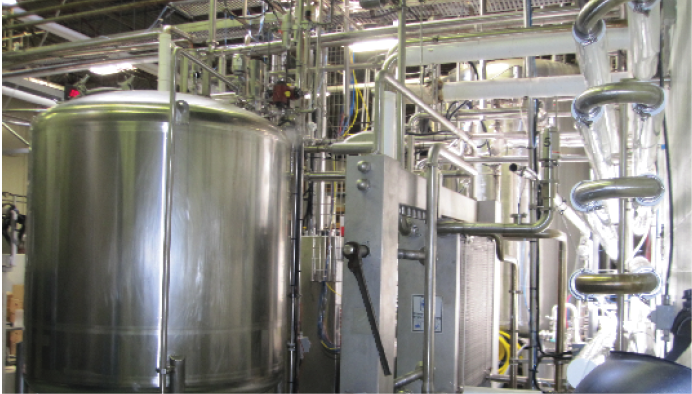
The heat exchanger (center, in the metal frame) quickly cools the mixture of juice and concentrate after it has been Pasteurized.
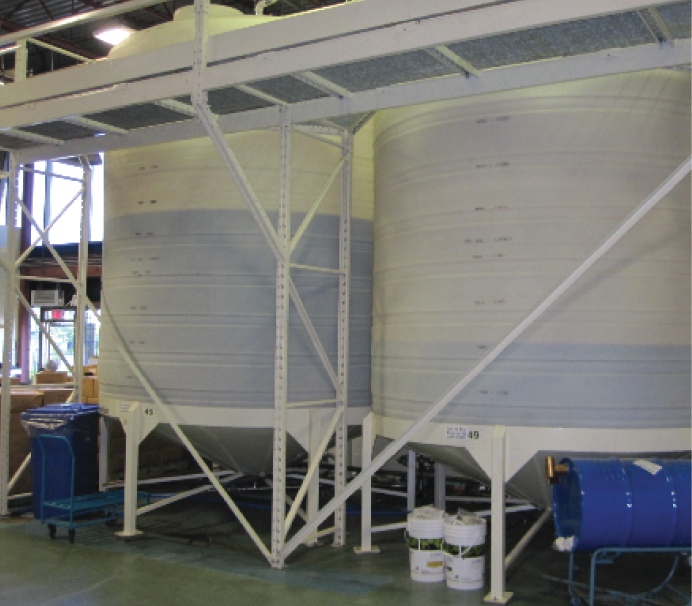
The grape concentrate in these tanks will remain stable for long periods of time due to its low pH and high sugar content. Grape concentrate is blended with juice in wine kits.



